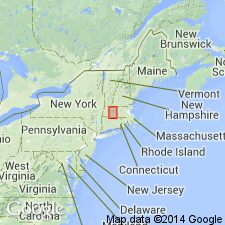
- Usage in publication:
-
- Goshen Formation*
- Modifications:
-
- Areal extent
- Overview
- AAPG geologic province:
-
- New England province
Summary:
Used as Goshen Formation of Early Devonian age. Extended into VT to the north and to CT to the south as shown on overlapping portions of the map in those states. Consists of one main body of well-bedded micaceous quartzite and quartz schist grading upward into light- to dark-gray, carbonaceous, aluminous schist in beds 5 to 15 cm thick; five informal subdivisions separately mapped are based on variations of the main unit, with variable types of granofels or schist.
Source: GNU records (USGS DDS-6; Reston GNULEX).

- Usage in publication:
-
- Goshen Formation*
- Modifications:
-
- Revised
- Areal extent
- AAPG geologic province:
-
- New England province
Summary:
Underlies approximately the western half of that part of Connecticut Valley belt that lies west of Mesozoic basin. At VT State line, Goshen is exactly continuous with Northfield Formation of southern VT. The name Goshen, rather than Northfield, is chosen for these rocks in MA because it has been applied to at least some of them in MA since Emerson's (1898) reports and because the relatively massive and faintly bedded rocks of Northfield Formation in VT change character quite dramatically a few miles south of MA-VT border. Rocks surrounding Granville dome in southernmost MA and adjacent CT were previously mapped as The Straits Schist by Schnabel (1974) and Knapp (1978). Because the Goshen and The Straits are correlative, authors have chosen Goshen for continuity in CT. The unit of planar-bedded schist and minor interbedded brown-weathering carbonate rock mapped as Waits River Formation by Hatch and Hartshorn (1968) northeast of Shelburne Falls dome is here reassigned to Goshen Formation. Contact between Goshen and Waits River is defined as the line along which, going eastward, character of schists changes from aluminous, quartz-poor, and planar-bedded to alumina-poor, contorted, and rich in quartz veins. Although Goshen is subdivided into six informal members on the MA State bedrock geologic map (Zen and others, 1983), all are characterized by at least some gray, graphitic, generally nonrusty-weathering schist. Three members are widespread and are found in consistent stratigraphic sequence in a north-south belt across the State. The other three members are found locally around the vicinity of the Shelburne Falls, Woronoco, and Granville domes. Early Devonian age is based on stratigraphic position and relations to Waits River and Gile Mountain Formations, and on fossil-based Silurian age of underlying rocks. [Papers presented as chapters in U.S. Geological Survey Professional Paper 1366 are intended as explanations and (or) revisions to MA State bedrock geologic map of Zen and others (1983) at scale of 1:250,000.]
Source: GNU records (USGS DDS-6; Reston GNULEX).
For more information, please contact Nancy Stamm, Geologic Names Committee Secretary.
Asterisk (*) indicates published by U.S. Geological Survey authors.
"No current usage" (†) implies that a name has been abandoned or has fallen into disuse. Former usage and, if known, replacement name given in parentheses ( ).
Slash (/) indicates name conflicts with nomenclatural guidelines (CSN, 1933; ACSN, 1961, 1970; NACSN, 1983, 2005, 2021). May be explained within brackets ([ ]).

